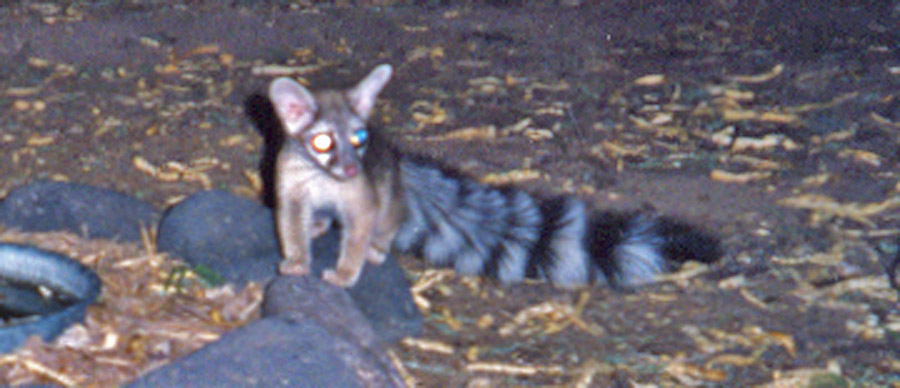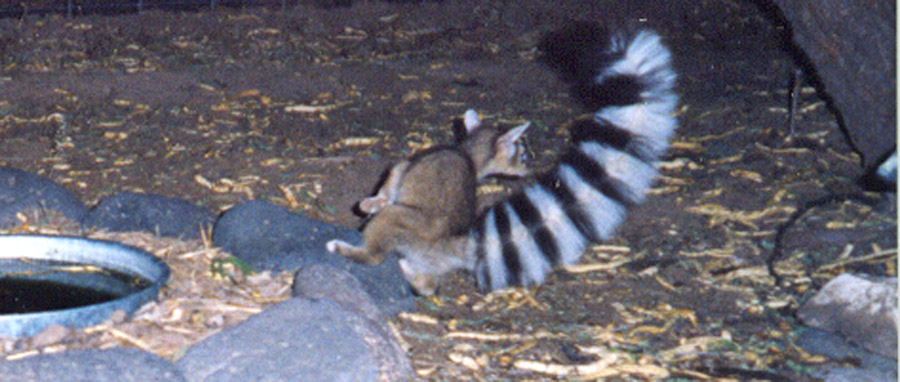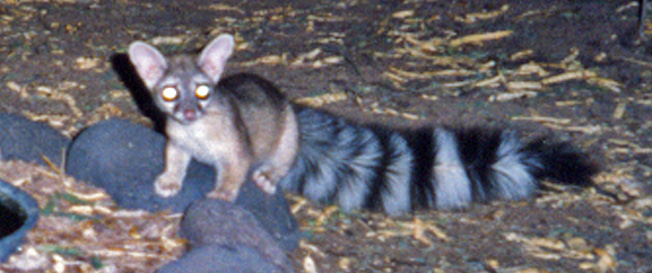Ringtail (Bassariscus astutus)

Main sources: Nowak, Ronald, 1991, Walker's Mammals of the world, Fifth Edition (two vols.), Baltimore: Johns Hopkins University Press; Hoffmeister, D. F., 1986, Mammals of Arizona, Tucson: University of Arizona Press; Burt, W. & R. Grossenheider, eds., 1976, A Field Guide to the Mammals, Peterson Field Guides: Houghton Mifflin; Eisenberg, John, 1980, The Mammalian Radiations, Chicago: University of Chicago Press.
Our images on this page were taken on March 31, 1999 at 8:23 pm in lower Hot Springs Canyon, using our infrared film camera with a flash attachment.
These small Procyonids range from southwestern Oregon and easter Kansas down into southern Mexico. (Another species extends from southern Mexico to Panama.) The Ringtail is distinguished from its two local, fellow Procyonids (the Raccoons and Coatimundis) by its outsized and very bushy tail displaying brightly contrasting black-&-white rings (see all three of our attached images), and by its considerably smaller size. Head and body length runs from 14-16", and the tail (so spectacular an appendage on this small animal that it looks artificial) is the same length or longer. Weight runs from 2 to 2 1/2 lbs. Upper parts of the body are "buffy, with a black or dark brown wash" (Nowak II:1099), while the underparts are white or white/buff. The animal's body is elongated, and its head seems rather small in relation to its large pointed ears and large eyes. The eye is ringed with black or dark brown, and the head has whitish patches.
Ringtails are unusually agile, excellent climbers on rocks, cliffs, and in trees. This one absconded in quick response to our camera's operations:

They prefer areas near water, nesting in caves & crevices. They are mainly nocturnal but often quite bold in the presence of humans, and may even occupy attics of occupied houses; in earlier days they were sometimes kept by settlers as pets & rodent-catchers. (The pair caught in the images on this page spent too much time in nocturnal dancing atop the metal roof of resident photographers, who finally removed the drinker near their house that you see here in order to encourage ringtail movement to trees somewhat further away.)
Ringtails feed on a wide variety of very small animals, and maintain rather small home ranges, sometimes living in pairs or small groups, but generally they are solitary except in the breeding season (February to May), after which the mother gives birth (from April to July) usually to 2-4 young. The offsprings' eyes open in about a month, and they usually become independent by 4 months. (Note the highly reflective retinas reflecting through the eyes of this nocturnal animal, as well as its distinctively long ears.)

Return to Mammals